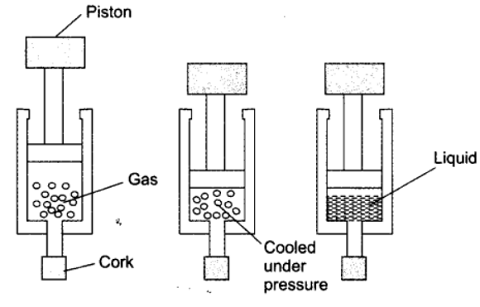
NCERT Solutions Class 9 Science Chapter 1: Matter is a fundamental concept in science, and it serves as the foundation for subjects covered in following classes.
NCERT Solutions Class 9 Science (Chemistry) Chapter 1 - Matter in Our Surroundings might help you learn more. Solutions are created with the assistance of dedicated teachers who have a deep conceptual knowledge and years of expertise.
The content is well-structured, making it easier for students to study and comprehend. In addition, the content in the NCERT Solutions has been updated to reflect the most recent NCERT curriculum.NCERT Solutions Class 9 Science Chapter 1 Important Questions
Question 1. Which of the following are matter? Chair, air, love, smell, hate, almonds, thought, cold, cold drink, smell of perfume. Solution: Anything that occupies space and has mass is called matter. Matter can exist in three physical states—solid, liquid, and gaseous. Chair and almond are forms of matter in the solid state. Cold drink is a liquid state of matter. Air is a gaseous state of matter.Question 3. A diver is able to cut through water in a swimming pool. Which property of matter does this observation show?
Question 5. The mass per unit volume of a substance is called density. (density = mass/volume). Arrange the following in order of increasing density – air, exhaust from chimneys, honey, water, chalk, cotton and iron.
| Differences in the characteristics of states of matter | |||
|
S. No . |
Solid state |
Liquid state |
Gaseous state |
|
1. |
Definite shape and volume. | No definite shape. Liquids attain the shape of the vessel in which they are kept. | Gases have neither a definite shape nor a definite volume. |
|
2. |
Incompressible | Compressible to a small extent. | Highly compressible |
|
3. |
There is little space between the particles of a solid. | These particles have a greater space between them. | The space between gas particles is the greatest. |
|
4. |
These particles attract each other very strongly. | The force of attraction between liquid particles is less than solid particles. | The force of attraction is least between gaseous particles. |
|
5. |
Particles of solid cannot move freely. | These particles move freely. | Gaseous particles are in a continuous, random motion. |
(b) Rigidity: It is the property of matter to maintain its shape even if external forces work and the solids show this property.
Compressibility: It is the property of matter to allow compression under high pressure and the gases show this property. Fluidity: It is the property of a substance to easily flow and allow change in its shape under external forces and this property is exhibited by both liquids and gases.Filling a gas container: Gases can be compressed easily hence they can be filled within a vessel at high pressure. This property of gases allows their convenient filling into a small container or cylinder and that also in a large volume. It also allows their easy transport from one place to the other e.g. CNG.
Shape: According to the type of matter shape differs depending upon location of particles like Solids have definite shape while Liquids acquire the shape of their container and gases as such don’t have any shape.Kinetic energy: It is the kind of energy present in an object when it is under motion as the particles of that object/matter are continuously moving therefore matter has kinetic energy. However greater is the movement more will be the kinetic energy and vice a versa i.e. solid < liquid < gas
Density: Mass per unit volume of a substance/matter is known as its density i.e. density = mass/volume Question 7. Give reasons:(a) A gas fills completely the vessel in which it is kept.
(b) A gas exerts pressure on the walls of the container.
(c) A wooden table should be called a solid.
(d) We can easily move our hand in air but to do the same through a solid block of wood we need a karate expert.
Solution:(a) Since the attraction force between particles of a gas is negligible i.e. extremely less hence particles freely move/flow in all possible directions as a result gas fills completely the vessel in which it is kept.
(b) Freely moving particles of gas hit the walls of its container continuously and randomly therefore such random and erratic motion of gas particles exerts pressure on the walls of the container.
(c) A wooden table particle is quite rigid, have a fixed location and also possess a definite shape and volume. Due to all these properties, we should call a wooden table a solid substance.
(d) Air is a mixture of gases and since particles of gas are far apart so same is true for air therefore, we can easily move our hand in air. But a solid block of wood is hard and rigid that resists any change in location of its particles hence we need a karate expert in case of a solid block of wood.
Question 8. Liquids generally have lower density as compared to solids. But you must have observed that ice floats on water. Find out why?Solution: (a) 300 K = (300 − 273)°C = 27°C (b)573 K = (573 − 273)°C = 300°C
Question 10. What is the physical state of water at: (a) 250°C (b) 100°C
Solution: (a) Water at 250°C exists in gaseous state. (b) At 100°C, water can exist in both liquid and gaseous form. At this temperature, after getting the heat equal to the latent heat of vaporization, water starts changing from liquid state to gaseous state.
Question 11. For any substance, why does the temperature remain constant during the change of state?
Solution: During a change of state, the temperature remains constant. This is because all the heat supplied to increase the temperature is utilised in changing the state by overcoming the forces of attraction between the particles. This heat is called the latent heat. Latent heat does not contribute in increasing the temperature of the substance. Question 12. Suggest a method to liquefy atmospheric gases. Solution: If we decrease temperature and increasing pressure we can liquefy the atmospheric gases.
 Question 13. Why does a desert cooler cool better on a hot dry day?
Question 13. Why does a desert cooler cool better on a hot dry day? Solution: When a liquid evaporates, the particles of the liquid absorb energy from the surroundings to compensate the loss of energy during evaporation. This makes the surroundings cool. In a desert cooler, the water inside it is made to evaporate. This leads to absorption of energy from the surroundings, thereby cooling the surroundings. Again, we know that evaporation depends on the amount of water vapour present in air (humidity). If the amount of water vapour present in air is less, then evaporation is more. On a hot dry day, the amount of water vapour present in air is less. Thus, water present inside the desert cooler evaporates more, thereby cooling the surroundings more. That is why a desert cooler cools better on a hot dry day.
Question 14. How does the water kept in an earthen pot (matka) become cool during summer?
Solution: The earthen pot is porous with lot of pores on it, the water oozes out through these pores and the water gets evaporated at the surface of the pot thereby causing cooling effect. This makes the pot cold and the water inside the pot cools by this process.
Question 15. Why does our palm feel cold when we put some acetone or petrol or perfume on it?
Solution: Acetone, petrol or perfume evaporate when they come into contact with air. The evaporation causes cooling sensation in our hands.
Solution: Saucer has a bigger surface area as compared to cup. Since evaporation is a surface phenomenon, by using a saucer instead of cup we are increasing the surface are for evaporation to occur. Faster evaporation of particles of tea or milk allows cooling and taking a sip becomes easier.
Question 17. What type of clothes should we wear in summer? Solution: We should wear light coloured cotton clothes in summer. Light colour because it reflects heat. Cotton clothes because it has pores in it, which absorbs sweat and allows the sweat to evaporate faster thereby giving cooling effect.
Key Features of NCERT Solutions Class 9 Science Chapter 1 – Matter in Our Surroundings
Below are the key features of the NCERT Solutions Class 9 Science Chapter 1 – Matter in Our Surroundings -- Content that is thoroughly explained, making sure that every idea is understood.
- The solutions, which were created by experienced educators and business professionals, are expressed in an understandable language.
- Includes inquiries from the most recent syllabus that is required.
- Thorough examination of past year's test questions
- Examine extra resources for learning, such as practice papers and question papers from prior years.
NCERT Solutions Class 9 Science Chapter 1 FAQs
Which are the chapters added in Class 9 Science as per the NCERT Science Book?
What is matter in our surrounding lesson?
What is the name of the first chapter of science class 9?
What are 5 examples of matter in our surroundings?
What is sublimation class 9?










